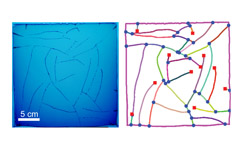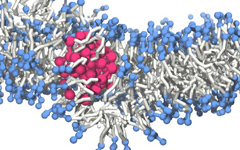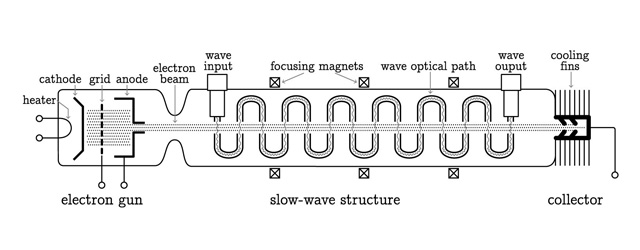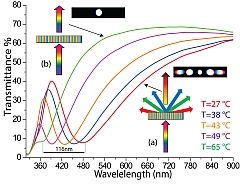Topology of fluid drainage fracture networks (Vol. 44 No. 5)
 Drainage fractures in gelatine layer. Blue circles – nodes, red squares – dead ends.
Drainage fractures in gelatine layer. Blue circles – nodes, red squares – dead ends.
Fluid generation in rocks is a common phenomenon: generation of hydrocarbons (oil\gas) from source rocks during diagenesis, dehydration of sedimentary and metamorphic rocks during burial and partial melting of the Earth’s mantle. Fluid generation leads to local increase in fluid pressure. If the rate of fluid production is high compared to the rate at which fluids can escape by flow through the initial permeability, the fluid pressure increases and may cause fracturing and creation of new fluid transport pathways.
This paper presents the development of fracture networks in a simple quasi-2D system consisting of a confined layer of gelatine containing yeast that consumes sugar to produce CO2. The topological properties of the emerging fracture networks were found to be intermediate between the tree-like structure of river networks and the fragmentation cracking patterns observed in drying muds, domain splitting during rock weathering and fracturing of cooling basalts. The ratio of the number of dead ends to the amount of nodes is ~0.4, between the ratio for rivers (=1) and fragmentation crack patterns (=0). Understanding of fluid drainage network topology is crucial for uncovering the mechanisms which lead to its formation.
M. Kobchenko, A. Hafver, E. Jettestuen, O. Galland, F. Renard, P. Meakin, B. Jamtveit and D. K. Dysthe, ‘Drainage fracture networks in elastic solids with internal fluid generation’, EPL, 102, 66002 (2013)
[Abstract]
Toward ultra-cold ion-atom chemistry (Vol. 45 No.3)
 Hybrid ion-atom trap setup in the Hudson lab. Inset on lower right shows an Yb ion chain immersed in ultra-cold Ca atoms.
Hybrid ion-atom trap setup in the Hudson lab. Inset on lower right shows an Yb ion chain immersed in ultra-cold Ca atoms.
The development of cold hybrid ion-atom traps has enabled researchers to explore a new frontier; atom-ion interactions at temperatures below 1 K. In a recent theoretical study we explored the reaction pathways of cold Ca atoms in collisions with the various isotopes of the Yb ion. At cold temperatures we found that the dominant reaction mode involves the creation of the YbCa+ molecular ion with the emission of a photon. That rate was found to be largely independent of the isotope and is consistent with Langevin behaviour which predicts a constant rate with very weak isotopic dependence. In ion-atom processes at cold temperatures Langevin behaviour is generic and has been verified in laboratory studies.
In our investigation we proceeded to the ultra-cold limit and found a temperature transition region in which Langevin behaviour breaks down, and the reaction rates exhibit enhanced isotopic sensitivity. Our studies suggest that dramatic isotopic dependence in hetero-nuclear ion atom reactions will manifest as laboratory advances coax charged gases to ever colder temperature.
B. Zygelman, Z. Lucic and E. R. Hudson, “Cold ion-atom chemistry driven by spontaneous radiative relaxation: a case study for the formation of the YbCa+ molecular ion”, J. Phys. B: At. Mol. Opt. Phys., 47, 015301 (2014)
[Abstract]
Towards high-temperature superconductors (Vol. 43 No. 2)
 Honeycomb lattice of graphene that provides the basis for new high-temperature superconductors.
Honeycomb lattice of graphene that provides the basis for new high-temperature superconductors.
Scientists have produced a new type of superconductor by manipulating graphene, the study of which led to a Nobel Prize. A team of Chinese scientists have manipulated the charge and the degree of freedom, known as spin, of electrons and their associated magnetic properties in a single-layer carbon material called graphene, making it suitable for applications involving superconductivity, a quantum mechanical phenomenon in which electrons travel in a material with no electrical resistance.
The authors investigated the means of exploiting a superconducting graphene flake. They looked at how unconventional electron pairing - known as d-wave pairing symmetries - would affect coherent subatomic - i.e., quantum - level transport within the material. In particular, they focused on electrical conductance in a system called a spin valve, which consists of two conducting magnetic materials, including a normal metal and graphene superconductor, the electrical resistance of which alternates from so-called giant magnetic resistance to none, depending on the alignment of its magnetic layers.
By reversing the magnetisation direction of one of the layers of the valve, researchers found that it is possible to achieve a spin-switch effect, whereby a normal current is converted into a superconducting current.
The authors hope that their theoretical results can provide the basis to design a spin-switch electron device able to operate at so-called high temperature, where liquid nitrogen can be used as a refrigerant.
Spin-switch effect in a graphene d-wave superconductor spin valve
C. Bai, J.T. Wang, H.X. Tang and Y.L. Yang, Eur. Phys. J. B 84, 83 (2011)
[Abstract]
Translocation of polymers through lipid bilayers (Vol. 43 No. 5)
 Snapshots of a polymer chain diffusing through the bilayer at the critical hydrophobicity. Strong perturbations of the lipid ordering can be observed during the adsorption/translocation event (middle).
Snapshots of a polymer chain diffusing through the bilayer at the critical hydrophobicity. Strong perturbations of the lipid ordering can be observed during the adsorption/translocation event (middle).
Lipid bilayers emerge by self-organization of amphiphilic molecules and are the essential component of membranes of living cells. An important task of them is the selective exchange of substances between the cell and its environment. This becomes particularly interesting for delivering foreign molecules and RNA into the cell. In the classical view of cell biology static structures such as pores and channels formed by specific proteins control the translocation of molecules.
In this work we show that there exists a straightforward mechanism for translocation of polymers through lipid bilayers if the monomers of the chain show a certain balance of hydrophobic and hydrophilic strength. Using the bond fluctuation method with explicit solvent to simulate the self-organized lipid bilayer and the polymer chain we show that the chain is adsorbed by the bilayer at a critical hydrophobicity of the monomers. At this point all monomers have an intermediate degree of hydrophobicity, which is large enough to overcome the insertion barrier of the ordered lipids, but still small enough to avoid trapping in the core of the bilayer. In a narrow range around this critical hydrophobicity the chain can almost freely penetrate through the model membrane whose hydrophobic core becomes energetically transparent here. Our simulations also allow calculate the permeability of the membrane with respect to the solvent. We show that the permeability is strongly increased close to the critical hydrophobicity suggesting that here the perturbation of the membrane patch around the adsorbed chain is highest.
J-U. Sommer, M. Werner and V. A. Baulin, ‘Critical adsorption controls translocation of polymer chains through lipid bilayers and permeation of solvent’, EPL, (2012) 98, 18003
[Abstract]
Transparent conducting device for electromagnetic waves (Vol. 45 No.4)
It is highly desirable to make a metal transparent for electromagnetic waves, owing to many application requests for transparent metals in optoelectronics devices. However, it is well known that a high-conducting metal with a high electron density is generally opaque for electromagnetic waves, since the metal’s permittivity is generally very negative at optical frequencies. Here, a freestanding transparent conducting device based on multilayer metamaterials is theoretically demonstrated at terahertz frequencies. It is realized by depositing periodic metallic patches on top and bottom of the subwavelength metallic mesh. The high transmission of the designed system is attributed to the impedance matching to the vacuum. This design of a transparent conducting device opens a high transmission window within the technologically relevant THz frequency range. This device may find plenty of applications in optoelectronic electrodes, micro-electronic displays, and the miniaturization and integration of THz components, where both high electrical conductivity and high optical transmission are desirable.
Z. Song, Z. Gao, Y. Zhang and B. Zhang, “Terahertz transparency of optically opaque metallic films”, EPL, 106, 27005 (2014)
[Abstract]
Trapping climate pollutant methane gas in porous carbon (Vol. 47 No. 1)

New adsorption of gas into porous carbon simulations are of interest to energy research and climate change mitigation.
As talks of global warming are once again making headlines, scientists have renewed their efforts to understand how to best limit its effects. For example, sequestrating short-lived climate pollutants, such as methane and black carbon, yields much faster reductions in global warming compared to reductions in CO2. To do so, it is essential to have a better grasp of the nature of physico-chemical properties of gases interacting with porous carbon. Now, a team of chemical engineering researchers has established ways of accurately simulating methane adsorption and desorption in carbon with nanopores. These findings have been published recently. Alternative applications for such findings are relevant for future energy research, such as energy storage and the development of natural gas extraction methods.
M. Lasich and D. Ramjugernath, Influence of unlike dispersive interactions on methane adsorption in graphite: a grand canonical Monte Carlo simulation and classical density functional theory study, Eur. Phys. J. B 88, 313 (2015)
[Abstract]
Trapping nanoparticles with optical tweezers (Vol. 52, No. 1)

Optical tweezers are a rapidly growing technology, and have opened up a wide variety of research applications in recent years. The devices operate by trapping particles at the focal points of tightly focused laser beams, allowing researchers to manipulate the objects without any physical contact. So far, optical tweezers have been used to confine objects just micrometres across – yet there is now a growing desire to extend the technology to nanometre-scale particles. Janine Emile and Olivier Emile at the University of Rennes, France, demonstrate a novel tweezer design, which enabled them to trap fluorescent particles just 200 nanometres across for the first time.
O. Emile, J. Emile, Nanometre optical trap based on stimulated emission in evanescence of a totally reflected Arago spot, Eur. Phys. J. E 43, 68 (2020)
[Abstract]
Traveling-wave tubes: The unsung heroes of space exploration (Vol. 50, No. 3)

An invention from the 1950s is still being used today
What do televisions and space exploration have in common? No, we’re not talking about a cheesy physics joke; rather, this is the story of an often-overlooked piece of equipment that deserves a place in the annals of telecommunication history. Some would argue that the traveling-wave tube (TWT) has not received the recognition it deserves when it comes to the history of space travel and communications – until now. A group of researchers has published recently a work looking into the history of TWTs. This is the first time a paper aimed at the general public has described the vital role of this technology in various areas of development. The team collected and read hundreds of papers on the history and evolution of the traveling-wave tube. First introduced in the 1950s, a TWT is a relatively simple piece of equipment used for transmitting data across long distances, including the vast expanses of space.
D.F.G. Minenna, F. Andre, Y. Elskens, J.-F. Auboin, F. Doveil, J. Puech and E. Duverdier (2019), The traveling-wave tube in the history of telecommunication, Eur. Phys. J. H 44, 1 (2019)
[Abstract]
Tumble-proof cargo transporter in biological cells (Vol. 47 No. 3)

New model shows how collective transport by synthetic nanomotors along biopolymer filaments can be effectively directed
Ever wondered how a molecular nanomotor works when repairing DNA or transporting material such as organelles in the cell? Typically, nanomotors move along biopolymer filaments to go about their duties in the cell. To do so, they use the energy of chemical reactions derived from their surroundings to propel themselves. In a new study published recently, the authors show that small synthetic motors can attach to polymeric filaments and--unlike what previous studies showed--move along without changing either their shape or the direction in which they set out to move. The authors studied the motions of these nanomotors on a filament surrounded by solvent by creating a coarse-grained level biomimetic model featuring all chemical species as particles. They found that the local concentration of catalytic product helping fuel their movement leads to a reversal of the direction of the collective movement of nanomotors, provided that they are in high enough concentration. The work promises to stimulate further research on directed cargo transport to effectively deliver the likes of anti-cancer drugs or anti-pollutants.
M-J. Huang and R. Kapral, Collective dynamics of diffusiophoretic motors on a filament, Eur. Phys. J. E 39, 36 (2016)
[Abstract]
Tuneable broadband optical filter based on soft-composite materials (Vol. 45 No.4)
 Spectral response versus temperature and schematic rapresentation of the filter mechanism in states ON (a) and OFF (b).
Spectral response versus temperature and schematic rapresentation of the filter mechanism in states ON (a) and OFF (b).
We realized a free-space, polarization sensitive, broadband, widely tunable, optical filter by exploiting a micro-composite holographic grating made of polymer slices alternated with films of aligned Nematic Liquid Crystals (NLC). Impinging probe light (p-polarized) experiences a refractive index modulation (Δng); thus, it is transmitted/diffracted and, consequently, angularly separated into its fundamental colours, according to the sketch of Figure (a). This diffraction effect induces a band-gap behaviour (filter in the ON state) in the transmission properties featured by the structure (Figure (a), red curve) and in the corresponding far field diffraction pattern. Both electric fields and temperature variations can be exploited to tune the position of the diffractive band-gap; in particular, by increasing the sample temperature, a nematic to isotropic transition of the NLC component gradually reduces Δng, with a resulting blue shift and a gradual suppression of the diffraction band (Figure (a), green curve). Under these conditions, light is almost completely transmitted (filter in the OFF state) as shown in the far field diffraction pattern and in the corresponding sketch reported in Figure (b).
L. De Sio, V. Caligiuri and C. Umeton, “Tuneable broadband optical filter based on soft-composite materials”, J. Opt., 16, 065703 (2014)
[Abstract]
Tunnelling of the 3rd kind (Vol. 44 No. 4)
 The incoming atom a emits a virtual photon c and enters an excited state b. After traversing the barrier they recombine and return to the original state. The mirrors on either side represent an optical cavity used to enhance the coupling of photons to the atom. The black walls denote potential barriers blocking both a and b, confining the atom and preventing contact with the mirrors.
The incoming atom a emits a virtual photon c and enters an excited state b. After traversing the barrier they recombine and return to the original state. The mirrors on either side represent an optical cavity used to enhance the coupling of photons to the atom. The black walls denote potential barriers blocking both a and b, confining the atom and preventing contact with the mirrors.
It is a fundamental property of quantum field theory that averaging over quantum fluctuations results in an effective theory that is non-local. Furthermore, it is possible that this effect can be demonstrated using a cavity quantum electrodynamics setup. In the proposed configuration (sketched in figure) the effective non-locality becomes evident in that an atom has a finite probability to traverse an arbitrarily high potential barrier. The atom, a, can "split" into a virtual excited state, b, and a virtual photon, c, which do not interact with the barrier, and can consequently cross it and recombine into the original atomic internal state. This so-called "tunnelling of the third kind" is distinct from regular quantum tunnelling (the "first kind") in that it relies upon the many-body interactions inherent to quantum field theory but absent from non-relativistic quantum mechanics; it is a purely quantum field theoretic effect.
Aside from its novelty as a gedankenexperiment, the process has the potential to stimulate some very interesting experiments in quantum optics and cold atom physics. Moreover, it may serve as a demonstration for "light-shining-through-walls" experiments that use comparable effects (real particle conversion - "tunnelling of the second kind") to search for particles beyond the Standard Model.
S. A. Gardiner, H. Gies, J. Jaeckel and C. J. Wallace, ‘Tunnelling of the 3rd kind: A test of the effective non-locality of quantum field theory', EPL, 101, 61001 (2013)
[Abstract]
Turbulence theory closer to high-energy physics than previously thought (Vol. 50, No. 3)

A new research paper finds the high-energy physics concept of 'un-naturalness' may be applicable to the study of turbulence or that of strongly correlated systems of elementary particles
Many scientists have been disappointed that no new elementary particles have been discovered at CERN's Large Hadron Collider in the wake of the Higgs boson discovery in 2012.The no-show of elusive particles that had previously been predicted by theory is only one example of a 'hole' that has recently appeared in the concept of Naturalness in theoretical physics. In simple terms, the concept states that physical parameters should depend roughly equally on all the terms used to calculate them, in terms of proportion. Sauro Succi, a theoretical physicist at the Fondazione Istituto Italiano di Tecnologia in Rome, Italy, has now published an intriguing essay in which he argues that several common natural phenomena do not operate under ‘Naturalness' at all. Rather, they can only be explained using parameters with widely separated numerical values.
S. Succi, Of Naturalness and Complexity, Eur. Phys. J. Plus 134, 97 (2019)
[Abstract]
Turbulences at a standstill (Vol. 43 No. 6)
 Probability distribution wn over linear wave modes n in (2) at time 107 for Β = 0:0 (dashed black), 0:05 (blue), 0:5 (magenta), 1 (red)
Probability distribution wn over linear wave modes n in (2) at time 107 for Β = 0:0 (dashed black), 0:05 (blue), 0:5 (magenta), 1 (red)
Energy flowing from large-scale to small-scale places may be prevented from flowing freely in specific conditions, similar to those found in disordered solids. In the present article, the author presents an exception he found in a model of turbulence, indicating that there are energy flows from large to small scale in confined space. Indeed, under a specific energy threshold, there are no energy flows, similar to the way electron currents and energy spreading are stopped in disordered solids.
The author relies on numerical simulations to study a kind of turbulence—known as Kolmogorov turbulence—that describes how energy flows from large to small scale in a confined space. According to this concept energy is introduced on large scales, e.g. by wind, and it is absorbed on small scales due to energy dissipation. This approach assumes that a small perturbation will make the system evolution chaotic as energy flows from large to small scales.
However, the author finds that a phenomenon normally observed in disordered metals, called Anderson localisation, which implies that there is no energy flow from one side of the metal to the other, also occurs with the type of turbulences he is focusing on. As a result, energy flow from large scale to small scale does not happen under specific circumstances where the energy level is below a certain threshold level. This result is in keeping with our intuitive experience of a small wind not creating a storm, and that wind needs to reach a certain threshold before a storm can be created.
D. Shepelyansky, ‘Kolmogorov turbulence, Anderson localization and KAM integrability’, Eur. Phys. J. B, 85, 199 (2012)
[Abstract]
Turbulent convection at the core of fluid dynamics (Vol. 43 No. 5)
Buoyant convection of a fluid subjected to thermal differences is a classical problem in fluid dynamics. Its importance is compounded by its relevance to many natural and technological phenomena. For example, in the Earth atmosphere, the study of thermal convection allows us to do weather forecasts and, on larger time and length-scales, climate calculations. In the oceans, where there are differences in temperature and salinity, turbulent convection drives deep-water currents. Geology and astrophysics are other areas where thermal convection has great impact. The simplest and most useful convection system is the Rayleigh-Bénard setup: a fluid in a container heated from below and cooled from above. In this classical system, the flow properties are determined by the scale and geometry of the container, the material properties of the fluid, and the temperature difference between top and bottom. The crux of the problem is to how to determine the rate of heat transfer in a given condition.
In this Colloquium paper, the authors review the recent experimental, numerical and theoretical advances in turbulent Rayleigh-Bénard convection. Particular emphasis is given to the physics and structure of the thermal and velocity boundary layers, which play a crucial role in governing the turbulent transport of heat and momentum in highly turbulent regimes. The authors moreover discuss some important extensions of Rayleigh-Bénard convection, such as the so-called non-Oberbeck-Boussinesq effects and address convection with phase changes.
F. Chillà and J. Schumacher, ‘New perspectives in turbulent Rayleigh-Bénard convection’, Eur. Phys. J. E (2012) 35: 58
[Abstract]
Turning graphene into light nanosensors (Vol. 49 No.5-6)

Tuning the graphene embedded in a photonic crystal by varying the external temperature can transform it into a light-sensitive sensor
Graphene has many properties; it is e.g. an extremely good conductor. But it does not absorb light very well. To remedy this limiting aspect of what is an otherwise amazing material, physicists resort to embedding a sheet of graphene in a flat photonic crystal, which is excellent for controlling the flow of light. The combination endows graphene with substantially enhanced light-absorbing capabilities. In a new study published recently, the authors demonstrate that, by altering the temperature in such a hybrid cavity structure, they can tune its capacity for optical absorption. They explain that it is the thermal expansion and thermo-optical effects which give the graphene these optical characteristics. Potential applications include light sensors, ultra-fast lasers, and systems capable of modulating incoming optical beams.
A. Rashidi and A. Namdar, Tunability of temperature-dependent absorption in a graphene-based hybrid nanostructure cavity, Eur. Phys. J. B 91, 68 (2018)
[Abstract]
Subcategories
- Highlights
- Vol. 41 No. 6 - Highlights
- Vol. 42 No. 3 - Highlights
- Vol. 41 No. 5 - Highlights
- Vol. 42 No. 1 - Highlights
- Vol. 42 No. 2 - Highlights
- Vol. 42 No. 4 - Highlights
- Vol. 42 No. 5 - Highlights
- Vol. 43 No.2 - Highlights
- Vol. 42 No. 6 - Highlights
- Vol. 43 No.1 - Highlights
- Vol. 43 No.3 - Highlights
- Vol. 43 No.4 - Highlights
- Vol. 43 No.5 - Highlights
- Vol. 43 No.6 - Highlights
- Vol. 44 No.1 - Highlights
- Vol. 44 No.2 - Highlights
- Vol. 44 No.3 - Highlights
- Vol. 44 No.4 - Highlights
- Vol. 44 No.5 - Highlights
- Vol. 45 No.1 - Highlights
- Vol. 45 No.2 - Highlights
- Vol. 45 No.3 - Highlights
- Vol. 45 No.4 - Highlights
- Vol. 45 No.5-6 - Highlights
- Vol. 46 No.1 - Highlights
- Vol. 46 No.2 - Highlights
- Vol. 46 No.3 - Highlights
- Vol. 46 No.4 - Highlights
- Vol. 46 No.5-6 - Highlights
- Vol. 47 No.1 - Highlights
- Vol. 47 No.2 - Highlights
- Vol. 47 No.3 - Highlights
- Vol. 47 No.5-6 - Highlights
- Vol. 48 No. 1 - Highlights
- Vol. 48 No. 2 - Highlights
- Vol. 48 No. 3 - Highlights
- Vol. 48 No.4 - Highlights
- Vol. 48 No.5-6 - Highlights
- Vol. 49 No.1 - Highlights
- Vol. 49 No.2 - Highlights
- Vol. 49 No.3 - Highlights
- Vol. 49 No. 4 - Highlights
- Vol. 49 No. 5-6 - Highlights
- Vol. 50 No. 1 - Highlights
- Vol. 50 No. 2 - Highlights
- Vol. 50 No. 3 - Highlights
- Vol. 50 No. 4 - Highlights
- Vol. 50 No. 5-6 - Highlights
- Vol. 51 No. 1 - Highlights
- Vol. 51 No. 2 - Highlights
- Vol. 51 No. 3 - Highlights
- Vol. 51 No. 4 - Highlights
- Vol. 51 No. 5 - Highlights
- Vol. 52 No. 1 - Highlights








